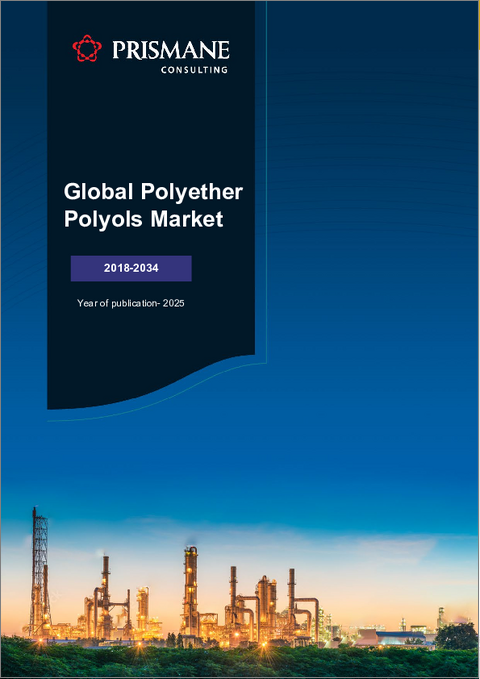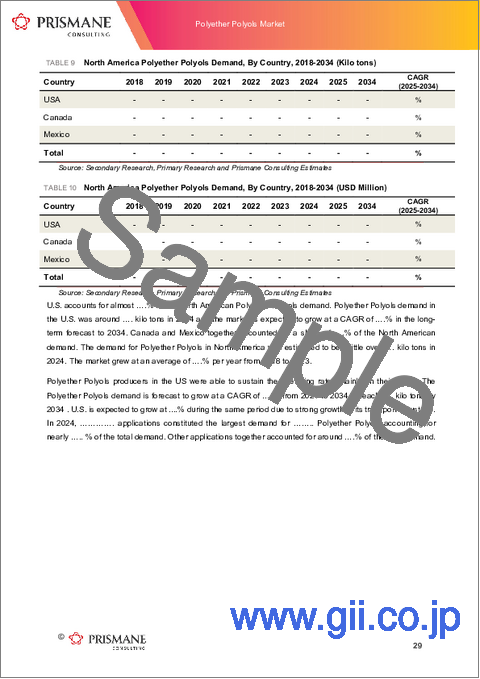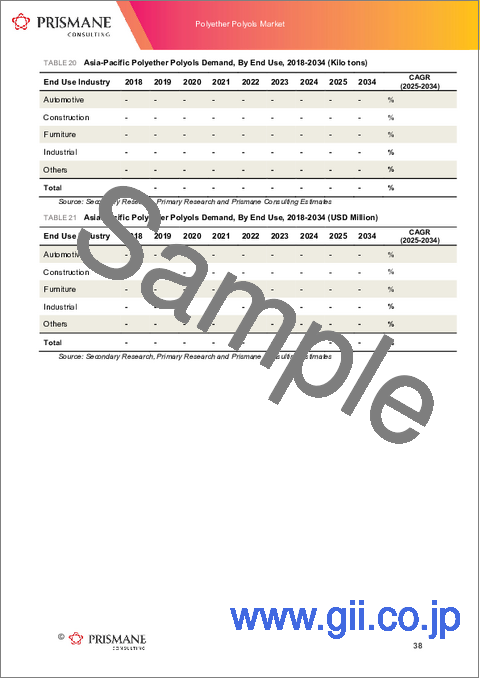|
|
市場調査レポート
商品コード
1761688
ポリエーテルポリオールの生産能力、生産高、需要、価格帯、予測(~2034年)Polyether Polyols Capacity, Production, Demand, Price Range and Forecast Report Till 2034 |
||||||
|
|||||||
| ポリエーテルポリオールの生産能力、生産高、需要、価格帯、予測(~2034年) |
|
出版日: 2025年04月07日
発行: Prismane Consulting
ページ情報: 英文 143 Pages
納期: 3~5営業日
|
全表示
- 概要
- 目次
世界のポリエーテルポリオールの市場規模は、2024年に180億米ドルであり、2034年までに300億米ドルを超えると予測され、CAGRで5.8%の安定した成長が見込まれます。
ポリエーテルポリオール市場は、COVID-19パンデミック中に一時的に後退し、自動車や家具などの主要部門の需要に影響を与えましたが、力強く回復しました。パンデミック後の回復は、経済成長と工業化が加速し続けている発展途上国市場、特にアジア太平洋におけるポリウレタンベースの製品に対する需要の増加によって促進されています。
世界のポリエーテルポリオール生産能力は2024年時点で約14,500キロトンであり、過去5年間の稼働率は65~75%でした。アジア太平洋が世界の生産能力をリードし、全体の60%超を占めており、西欧(18%)、北米(15%)がこれに続きます。また、この地域は、自動車、建築、家具部門からの需要の増加により、今後数年間で1,100キロトンの生産能力が追加されると予測されています。Covestro、Dow Chemicals、Shell Chemicals、BASF、Wanhua、Zibo Dexin Liangbang Chemicalなどがポリエーテルポリオールの主要メーカーです。
需要側では、アジア太平洋が世界のポリエーテルポリオール消費の約55%を占め、再び優位に立っています。西欧と北米は合わせて約35%を占め、残りの需要はその他の地域に分散しています。この動向は、アジアにおける製造拠点の増加だけでなく、新興経済国におけるインフラ開発と消費者需要の増加を反映しています。
今後、ポリエーテルポリオール市場は健全な成長が見込まれます。ポリエーテルポリオールは、特に自動車用内装、断熱材、家具などのポリウレタンフォーム用途と強い結びつきがあるため、従来の産業と発展途上の産業の両方において重要な材料となっています。軽量でエネルギー効率の高い持続可能な材料へのシフトも、ポリエーテルポリオール需要に恩恵を与えると予測されます。
当レポートでは、世界のポリエーテルポリオール市場について調査分析し、市場力学と産業動向、各セグメントの需要、メーカーのプロファイルなどの情報を提供しています。
目次
第1章 イントロダクション
第2章 市場の要約
- 市場の進化
- 需要の概要
- 産業構造
- 戦略上の問題
- 最終用途の動向
- 成長予測
第3章 経済とエネルギーの見通し
- GDPと人口動態
- 金融政策と財政政策
- 原油生産と価格
- 天然ガス
- 電気料金
第4章 最終用途部門の実績
- 自動車
- 建築・建設
- 電気・電子
- 工業
- その他
第5章 ポリエーテルポリオールのイントロダクションと市場の概要
- 製品の説明
- グレードと特性
- 原材料
- 製造プロセス
- 環境問題
- バリューチェーン
- 用途
第6章 市場力学と産業動向
- 市場力学
- 促進要因
- 抑制要因
- 機会
- 課題
第7章 世界のポリエーテルポリオール需要の分析:用途別、最終用途産業別(数量と金額)(2018年~2034年)
- 戦略上の問題とCOVID-19の影響
- 需要の分析と予測(2018年~2034年)
- 需要
- 需要成長率
- 促進要因の分析
- 世界のポリエーテルポリオール市場:用途別
- ポリウレタンフォーム
- 軟質
- 硬質
- 接着剤・シーラント
- エラストマー
- 表面コーティング
- その他
- 世界のポリエーテルポリオール市場:最終用途産業別
- 自動車
- 建設
- 家具
- 冷蔵
- 工業
- その他
第8章 需要の分析と市場のレビュー:地域/国別(数量と金額)(2018年~2034年)
- 戦略上の問題とCOVID-19の影響
- 需要の分析と予測(2018年~2034年)
- 需要
- 需要成長率
- ポリエーテルポリオール市場:用途別
- ポリエーテルポリオール市場:最終用途産業別
- 北米
- 米国
- カナダ
- メキシコ
- 西欧
- ドイツ
- フランス
- イタリア
- 英国
- スペイン
- その他の西欧
- 中欧・東欧
- ロシア
- ポーランド
- その他の中欧・東欧
- アジア太平洋
- 中国
- 日本
- インド
- 韓国
- その他のアジア太平洋
- 中南米
- ブラジル
- その他の中南米
- 中東・アフリカ
- GCC
- その他の中東・アフリカ
第9章 価格分析
第10章 主な戦略上の問題と事業機会の評価
- 市場の魅力の評価
- 見通しとターゲット市場の調査
第11章 戦略的推奨と提案
第12章 企業分析
- ポリエーテルポリオールメーカーのプロファイル/企業分析
- 基本詳細
- 本社、主要市場
- 所有
- 企業の財務
- 製造拠点
- 世界の売上
- 総従業員数
- 製品ポートフォリオ/サービス/ソリューション
- 採用された主な事業戦略とPrismane Consultingの概要
- 近年の発展
- 対象企業
- Sadara
- Covestro AG
- Royal Dutch Shell
- China Petroleum & Chemical Corporation
- BASF
- Monument Chemical
- KPX Chemical
- Repsol Group
- Huntsman Corporation
- Oltchim
- PCC Rokita
- Wanhua Group
- Jiahua Chemical
- Shandong Longhua New Material
- その他のメーカー
第13章 付録
The global Polyether Polyol market, valued at USD 18 billion in 2024, is projected to surpass USD 30 billion by 2034, growing at a steady CAGR of 5.8%. Polyether polyols are essential chemical ingredients primarily used in the production of polyurethane foams both flexible and rigid as well as in non-foam applications such as adhesives, sealants, elastomers, and surface coatings.
These polyols play a central role in industries like automotive, construction, furniture, and refrigeration. Their unique physical properties, including low glass transition temperature, make them highly effective for applications requiring durability and impact resistance in a wide range of temperatures.
Despite a temporary setback during the COVID-19 pandemic, which affected demand across key sectors like automotive and furniture, the polyether polyol market has rebounded strongly. The post-pandemic recovery is being driven by increasing demand for polyurethane-based products in developing markets, especially in Asia Pacific, where economic growth and industrialization continue to accelerate.
As of 2024 global production capacity for polyether polyols stood at around 14,500 kilotons, with operating rates ranging from 65% to 75% over the past five years. Asia Pacific leads global production capacity, accounting for over 60% of the total, followed by Western Europe (18%) and North America (15%). The region is also expected to add an additional 1,100 kilotons of capacity in the coming years, driven by rising demand from the automotive, construction, and furniture sectors. Covestro, Dow Chemicals, Shell Chemicals, BASF, Wanhua and Zibo Dexin Liangbang Chemical, are some of the leading polyether polyol producers.
On the demand side, the Asia Pacific region again dominates, accounting for around 55% of global polyether polyols consumption. Western Europe and North America together make up about 35%, with the remaining demand spread across other regions. This trend reflects not only the growing manufacturing footprint in Asia but also increasing infrastructure development and consumer demand in emerging economies.
Looking forward, the polyether polyol market is poised for healthy growth. Its strong connection to polyurethane foam applications particularly in automotive interiors, insulation materials, and furniture makes it a key material in both traditional and evolving industries. The shift toward lightweight, energy-efficient, and sustainable materials is also expected to benefit polyether polyol demand, as manufacturers explore advanced formulations to meet environmental and regulatory standards.
Table of Contents
1. Introduction
- Scope
- Market Coverage
- Applications
- End-Use Industries
- Regions
- Countries
- Years Considered
- Historical - 2018 - 2023
- Base - 2024
- Forecast Period - 2025 - 2034
- Research Methodology
- Approach
- Research Methodology
- Prismane Consulting Market Models
- Assumptions & Limitations
- Abbreviations & Definitions
- Conversion Factors
- Data Sources
2. Market Synopsis
- Market Evolution
- Demand Overview
- Industry Structure
- Strategic Issues
- End-use Trends
- Growth Forecast
3. Economic & Energy Outlook
- GDP and Demographics
- Monetary & Fiscal Policies
- Crude Oil Production and prices
- Natural Gas
- Electricity Prices
4. End-use Sector Performance
- Automotive
- Building & Construction
- Electrical & Electronics
- Industrial
- Others
5. Introduction to Polyether Polyols and Market Overview
- Product Description
- Grades & Properties
- Raw Material
- Manufacturing Process
- Environmental Issues
- Value Chain
- Applications
6. Market Dynamics and Industry Trends
- Market Dynamics
- Drivers
- Restraints
- Opportunities
- Challenges
7. Global Polyether Polyols Demand Analysis, By Applications, By End-Use Industries (Volume, Value) (2018-2034)
- Strategic Issues and COVID-19 Impact
- Demand Analysis and Forecast (2018- 2034)
- Demand
- Demand Growth Rate (%)
- Driving Force Analysis
- Global Polyether Polyols Market, By Applications
- Polyurethane Foam
- Flexible
- Rigid
- Adhesives & sealants
- Elastomers
- Surface coatings
- Others
- Global Polyether Polyols Market, By End-Use Industries
- Automotive
- Construction
- Furniture
- Refrigeration
- Industrial
- Others
8. Demand Analysis and Market Review, By Region, By Country (Volume, Value), (2018- 2034)
- Strategic Issues and COVID-19 Impact
- Demand Analysis and Forecast (2018 - 2034)
- Demand
- Demand Growth Rate (%)
- Polyether Polyols Market, By Applications
- Polyether Polyols Market, By End-Use Industries
Note: Demand Analysis has been provided for all major Regions / Countries as mentioned below. The demand (consumption) split by applications and end-use industries have been provided for each of the countries / regions in Volume (Kilo tons) and Value (USD Million).
- North America
- USA
- Canada
- Mexico
- Western Europe
- Germany
- France
- Italy
- United Kingdom
- Spain
- Rest of Western Europe
- Central & Eastern Europe
- Russia
- Poland
- Rest of Central & Eastern Europe
- Asia-Pacific
- China
- Japan
- India
- South Korea
- Rest of Asia-Pacific
- Central & South America
- Brazil
- Rest of Central & South America
- Middle East & Africa
- GCC
- Rest of Middle East & Africa
Note: CAGR will be calculated for all applications and end-use industries to arrive at the regional / global demand growth for the forecast period (2025 - 2034)
9. Pricing Analysis
10. Key Strategic Issues and Business Opportunity Assessment
- Market Attractiveness Assessment
- Prospective & Target Market Study
11. Strategic Recommendation & Suggestions
12. Company Analysis
- Polyether Polyols Manufacturers Profiles/ Company Analysis
- Basic Details
- Headquarter, Key Markets
- Ownership
- Company Financial
- Manufacturing Bases
- Global Turnover
- Total Employee
- Product Portfolio / Services / Solutions
- Key Business Strategies adopted and Prismane Consulting Overview
- Recent Developments
- Companies Covered -
- Sadara
- Covestro AG
- Royal Dutch Shell
- China Petroleum & Chemical Corporation
- BASF
- Monument Chemical
- KPX Chemical
- Repsol Group
- Huntsman Corporation
- Oltchim
- PCC Rokita
- Wanhua Group
- Jiahua Chemical
- Shandong Longhua New Material
- Other Manufacturers
Note: This section includes company information, company financials, manufacturing bases and operating regions. Company financials have been mentioned only for those companies where financials were available in SEC Filings, annual reports, or company websites. All the reported financials in this report are in U.S. Dollars. Financials reported in other currencies have been converted using average currency conversion rates. Company profiles may include manufacturers, suppliers, and distributors.
13. Appendices
- Demand - Regions
- Demand - Countries






